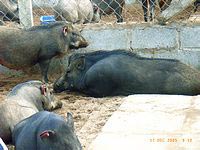Raising wild boars is not difficult. Some people even naively believe that it is easier than raising domestic pigs. Wild boars do not need to be raised in the forest; they can be raised anywhere. However, it is essential to understand some of their characteristics and behaviors to arrange suitable housing for them.
–
 |
|
Raising Wild Boars (Photo: KHKTNN) |
It is advisable to choose high and well-drained land to set up a wild boar enclosure. Avoid low, swampy areas where water collects or where drainage is poor. The area should also have a clean water source. This not only provides sufficient drinking water for the boars but, more importantly, it maintains a rich plant ecosystem in their living environment and keeps the humidity at an appropriate level.
– Do not utilize old pig sties that have housed domestic pigs for raising wild boars. The lingering pathogens from domestic pigs can infect wild boars. Additionally, the further the enclosure is from residential areas and roads, the better. Their wild instincts make them very alert and prone to panic and flee at the slightest noise.
– The wild boar enclosure should have plenty of trees, ideally dense foliage. While wild boars are fierce, they are also quite timid. However, it’s important to create sunny areas within the enclosure where they can bask in the sunlight. They can be raised either in a pen (like domestic pigs) or allowed to roam freely within a fenced area. At Lý – Thanh – Sắc Company, a pen was built (10 meters wide and approximately 80 meters long) for free-range wild boars. The area is densely planted with cassava and bamboo. They also provided a shelter for them to stay dry during rain. The boars primarily hide in the underbrush. Importantly, the fencing must be very sturdy. Walls can be built, or B40 netting can be used around the enclosure. Care should be taken to prevent them from digging holes to escape.
When wild boars are first brought to a new environment, they often panic and try to escape. Sometimes, they may become aggressive and attempt to break out of their pen. Patience and gentle handling are crucial. Initially, they may refuse to eat and go on a hunger strike. However, they cannot go without water. Therefore, it is essential to prepare a water trough for them ahead of time. After a while, once they realize they cannot escape, the boars will gradually adapt to their new surroundings and seek out food.
The diet of wild boars mainly consists of plant material. It is not advisable to overfeed them with highly nutritious food, as this can alter the quality of the wild boars and may sometimes lead to diarrhea.
There are two types of feed:
– Rough feed includes: Banana plants, banana leaves, young corn stalks, water spinach, various types of grass, green fruits, etc.
– Concentrated feed: This type of feed is low in fiber and has a higher nutritional content. It includes rice, bran, corn, beans, sweet potatoes, cassava, etc. It is necessary to adjust the amount of feed according to each growth stage and control their portions.
It is also essential to implement good disease prevention measures for them. Wild boars are often susceptible to various diseases such as: swine fever, diarrhea, anthrax, foot-and-mouth disease, liver fluke disease, mange, and others. When they become ill, they should be isolated and treated as one would with domestic pigs.
Breeding wild boars can either focus on creating purebred lines or producing hybrid generations. It is mandatory that the male is always a purebred wild boar.
While many principles must be followed, in general, raising wild boars is not difficult. Currently, the market demands a significant amount of wild boar meat. Therefore, this is a profession worth pursuing.


















































